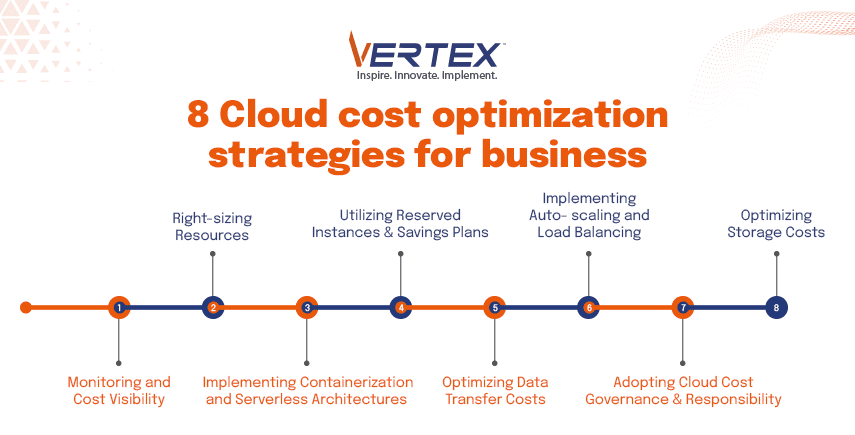
Sudip Nandy
June 10, 2024Optimizing cloud cost strategies for businesses
Cloud computing has revolutionized modern business operations. Its inherent scalability, flexibility, and potential for cost-effectiveness have made it a strategic imperative for organizations of all sizes.
However, the benefits of the cloud — its on-demand nature and seemingly limitless resources — can lead to unintended consequences if proper cost management practices are not implemented. Uncontrolled cloud spending can quickly disrupt meticulously crafted budgets and negatively impact an organization’s financial health.
In this blog, we will discuss strategies for optimizing cloud costs and provide solutions for businesses.
8 Cloud cost optimization strategies for busines

1. Right-sizing resources
Resource allocation optimization is one of the main ideas in cloud cost management. Cloud providers have samples and sizes for various types of workloads in the cloud infrastructure. Occasionally, the models are oversold, implying that the business is paying for a capacity it does not require.
Therefore, by constantly observing the usage of the resource and the scaling of the samples to the actual demand, organizations cannot afford to pay more. Management and automation tools help us to determine resource utilization and bring them to the maximum level of usage to reduce costs.
2. Utilizing reserved instances and savings plans
RIs provide significant discounts if the company commits to using particular model types in AWS, Azure, or Google Cloud for one or three years. Savings plans are more flexible in that they can be used to apply discounts to other types of usage in AWS and Azure.
These purchasing options can, however, be useful in the sense of realizing cost savings where the workload is constant or the application is more or less constant. This will help the RIs and the savings plans with the changing usage patterns.
3. Implementing auto-scaling and load balancing
Auto-scaling and load balancing are two of the most significant strategies. This can be applied to cloud computing to cut down costs while increasing the scalability of performance. Another feature is the ability to scale up or down the number of compute resources depending on the traffic.
Companies can increase their capacity in times of high demand and reduce it in times of low demand, so they do not have to invest excessively and can reduce costs.
4. Optimizing storage costs
Another cost strategy in clouds is the storage cost. This is directly proportional to the size of the data. The second recommendation is to sort the data by usage and then apply the tier storage system to reduce the costs of storing.
Cloud providers have hot storage for data that is often accessed, cool storage for data that is accessed occasionally, and cold storage for data that is accessed rarely. When data is linked to the appropriate tier and lifecycle management policies are implemented, organizations can store data inexpensively.
5. Monitoring and cost visibility
Cloud providers have integrated tools that are used to build applications. This is because through the monitoring of the usage of resources and the costs incurred thereon, one is in a position to identify fluctuations in costs, forecast future costs and take appropriate action on costs.
Real-time notifications and boards are helpful in decision-making because the stakeholders can monitor and control the costs in real time.
6. Implementing containerization and serverless architectures
Containers are beneficial for resource management as they bundle applications and all the related dependencies into small and manageable units that can be shipped. Kubernetes and Docker Swarm are resource management tools that help with the allocation and management of resources, so the costs of using virtual machines are not present.
The serverless computing model frees the organization from the responsibility of managing the infrastructure and charges only for its use. These modern architectures help organizations to deploy and manage their applications with relative ease and at a lower cost.
7. Optimizing data transfer costs
The costs of data transfer between inter-regional or inter-cloud services can rise rapidly. To minimize the cost of data transfer, it is recommended that the business evaluate its data transfer requirements and then take advantage of the CDN or direct connect services provided by the cloud providers.
Additional optimization of the network settings and data compression techniques minimize the costs of data transmission even further, which enables efficient data management in distributed systems without any loss of throughput.
8. Adopting cloud cost governance and responsibility
Policies, budgets, and chargeback systems help stakeholders monitor the usage and adherence to the cost management plan and allocate costs fairly to departments or projects.
The management also conducts cost control checks and reviews occasionally to check on the extent of compliance with the cost-saving strategies and other possible savings. The culture of cost consciousness and cost responsibility makes sure that organizations make the best out of the cloud by using it to the fullest.
Unleashing the power of the cloud
Cloud cost management is a continuous process that should be carried out and planned from time to time. Hence, through the adoption of these strategies, firms ensure that they are in a position to remain competitive, flexible, and sustainable as they embark on the cloud transition.
Want to transform your business with innovative solutions? Contact Vertex and we will help you scale your business.
Recent Blogs

28 April, 2025

21 April, 2025

14 April, 2025

7 April, 2025

24 March, 2025

17 March, 2025

10 March, 2025

3 March, 2025
Recent News

2 February, 2025

14 November, 2024

4 November, 2024

1 August, 2024

6 March, 2024

28 February, 2024

12 June, 2023



